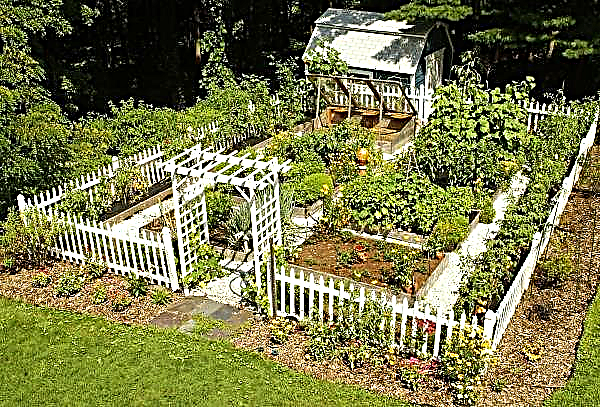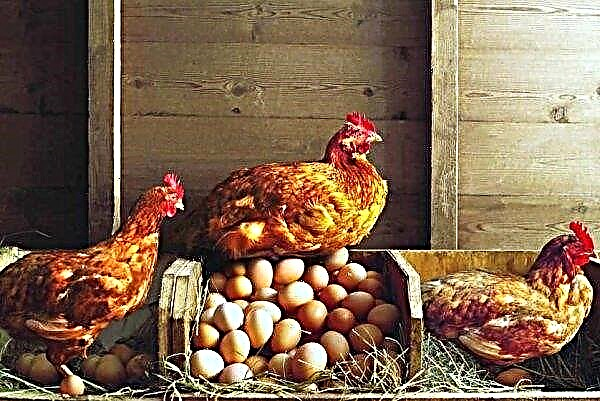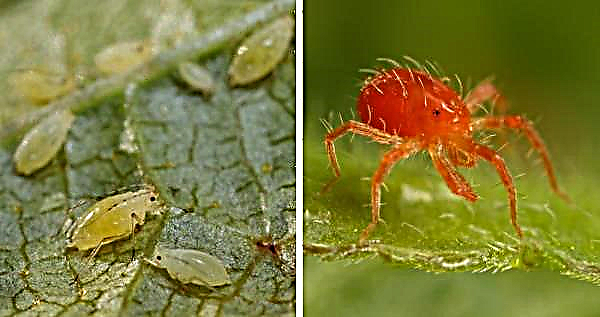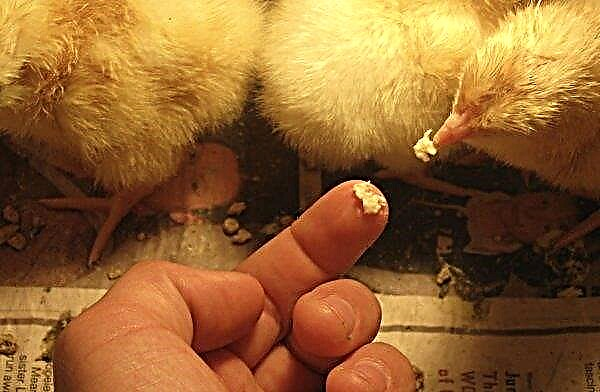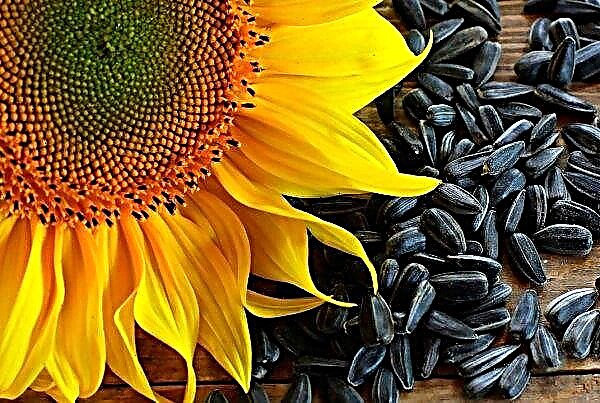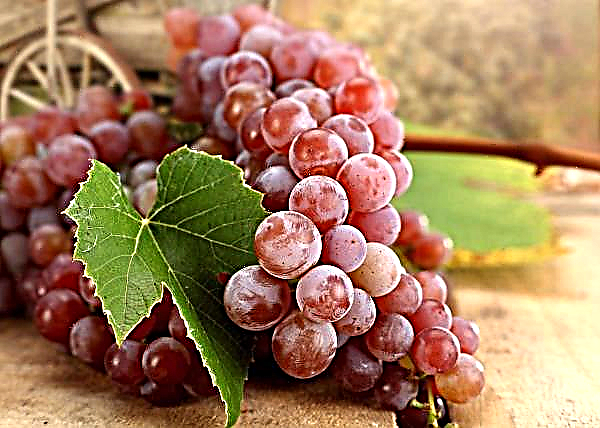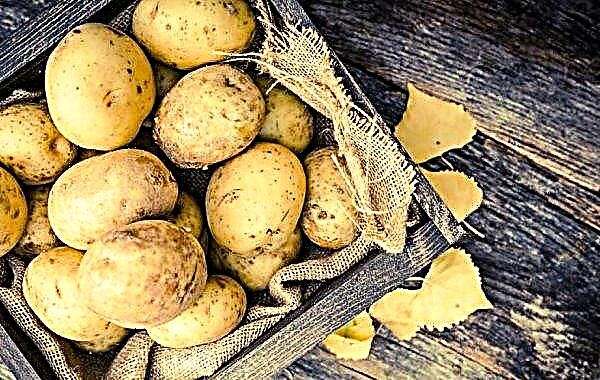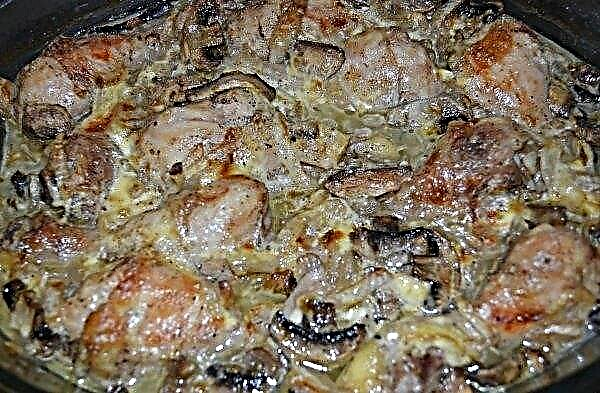To annually get a high tomato crop, first of all, you should choose the right variety. Today, breeders have bred many species that can grow in various climatic regions, withstand difficult weather conditions and are resistant to diseases and pests. The article below is devoted to the description of the variety Yablonka of Russia.
Characterization and description of the variety
Bred by breeders in Russia in the 80s of the last century. In 2000, the variety was included in the State Register as a vegetable plant, recommended for cultivation in open beds.
Did you know? The famous botanist (originally from Sweden) Karl Linney, who gave Latin names to a huge number of plants, called the tomato Solanum lycopersicum, which means «wolf peach». Until the XVIII century, the fruits of tomato bushes in Europe and America were considered poisonous.
Due to the simplicity of care and the lack of need for special efforts during cultivation, gardeners called it "a variety for the lazy."
Tomato Characteristics:
- ripen in the early stages - the first fruits are formed 100–118 days after emergence;
- bushes are determinant, shtambovye, 100-130 cm high;
- the crown of the bush is compact, with an average number of strong, thickened shoots and leaves of the potato type;
- the first ovary is formed after 7–9 leaves;
- bear fruit for a long time, plentifully - up to 100 fruits are formed on the bush;
- round-shaped fruits;
- peel of tomatoes is smooth, not stiff, does not crack;
- fruit color is bright red;
- the average weight of the fetus is 100–110 g;
- the yield of the variety is 5.5 kg per 1 sq. km. m;
- the pulp is juicy, moderately dense, sweet and sour to taste, aromatic;
- in fruits 2 chambers and a lot of seeds;
- show resistance to major diseases and drought;
- tolerate temperature jumps well;
- the fruits have a universal purpose - they are used fresh, for winter harvesting, making juice, sauces;
- perfectly maintain appearance after transportation;
- distinguished by good keeping quality;
- can be cultivated in open and closed ground.
Photo gallery
Advantages and disadvantages
- Tomatoes of the variety Yablonka of Russia have a number of advantages:
- consistently high yield;
- fruit storage duration;
- the same size of the fruit;
- fruiting duration;
- resistance of fruits to cracking;
- good resistance to diseases and pests;
- good survival in severe weather conditions;
- easy care;
- not a hybrid, can propagate by its own seeds.
No flaws were detected in the variety.
Cultivating varieties
Like most varieties, tomatoes Yablonka Russia are grown using seedlings. This allows you to get strong, healthy plants and achieve maximum yield. Seedlings need care and the creation of conditions for development: the necessary temperature and humidity, the selection of soil and tanks. The seed planting method can be used only in those regions where there is a warm climate and minimal risk of frost in May, early June, and sudden changes in temperature.
The seed planting method can be used only in those regions where there is a warm climate and minimal risk of frost in May, early June, and sudden changes in temperature.
The necessary conditions
Tomatoes Yablonka of Russia are thermophilic and grow well in such conditions:
- in a sunny, calm place, protected from the north side;
- at air temperature - +20 ... + 25 ° С;
- with air humidity - 60–70%;
- in good light;
- in loamy soil enriched with nutrients;
- on a site where green manure, cucumbers, turnips, cauliflower, green onions, carrots, beets were previously cultivated.
Important! It is better not to grow tomatoes in the beds where potatoes, tomatoes, peas, and zucchini grew. These crops deplete the soil for the nutrients needed by tomatoes.
Seed sowing technology
Seeds for seedlings are sown in early March. For their planting, suitable containers and soil are preliminarily prepared. You can sow seeds in containers that are available on the farm - for example, a long wooden or cardboard box, a rectangular plastic flower pot, and disposable 200-gram glasses. You can buy containers in a specialized store - peat pots, tablets, cassettes.
You can sow seeds in containers that are available on the farm - for example, a long wooden or cardboard box, a rectangular plastic flower pot, and disposable 200-gram glasses. You can buy containers in a specialized store - peat pots, tablets, cassettes.
Sprouting soil can also be bought at the store. A peat substrate is good. The soil with the optimal composition can be made with your own hands. This will require:
- peat - 2 parts;
- turf land - 1 part;
- humus (compost) - 1 part;
- sand - 0.5 parts.
- Watering with a solution of potassium permanganate (1%).
- Watering with the Fitosporin preparation (according to the instructions).
- Calcination in the oven (microwave) at a temperature of +70 ... + 90 ° С.
 After processing, the substrate must be moistened and held at room temperature for 24 hours. Seeds purchased in the store do not require disinfection - this procedure was done by manufacturers. They can, but not necessarily, be soaked in a growth stimulator (Epin, Zircon, Gumat) for 10-12 hours. This will help them hatch faster.
After processing, the substrate must be moistened and held at room temperature for 24 hours. Seeds purchased in the store do not require disinfection - this procedure was done by manufacturers. They can, but not necessarily, be soaked in a growth stimulator (Epin, Zircon, Gumat) for 10-12 hours. This will help them hatch faster.If you independently collect seed material or purchase it from an unverified seller, decontamination is required. To do this, use a solution of potassium permanganate (soaked in it for 20 minutes), a solution of hydrogen peroxide, heated to +40 ° C (processing time - 20 minutes). After disinfection, you can soak the seeds in warm water for 18 hours or in a growth stimulator.
After preliminary preparation, the seeds are planted according to this scheme:
- Make furrows in the substrate with a depth of 1-1.5 cm.
- Place tweezers in them for 1-2 seeds at a distance of 1-2 cm.
- Fill the soil with a 0.5-centimeter layer.
- To water.
- Cover with foil or glass.
 The following conditions must be created for seedlings:
The following conditions must be created for seedlings:
- air temperature - +24 ... + 26 ° С;
- air humidity - 60–70%;
- good lighting - 14-16 hours (if necessary, organize artificial lighting).
Did you know? Breeders have bred varieties of tomatoes in which fruits are formed not only red, pink and yellow, but also black, purple, brown.
Seedling Care
Seedling care involves regular hydration, daily ventilation, periodic picking, top dressing and hardening.
Watering is carried out using a spray gun. In this way, leaching of seeds from the soil and damage to fragile shoots can be avoided. For irrigation use settled, rain or filtered water at room temperature. Recommended frequency of hydration at intervals of 7-10 days.
Airing is necessary while the shoots are under cover, that is, in the first 3-4 days after sowing, before the shoots appear. If it is not produced, then there is a threat of the development of fungal diseases. The formation of sprouts on stems of 1-2 leaves is the period when seedlings need to be dived, that is, transplanted if it grows in separate containers, or transplanted into different pots when grown in a common container. Dive soil should be nutritious.
The formation of sprouts on stems of 1-2 leaves is the period when seedlings need to be dived, that is, transplanted if it grows in separate containers, or transplanted into different pots when grown in a common container. Dive soil should be nutritious.
After picking, seedlings continue to be watered as needed. Watering is stopped a few days before the plan for planting seedlings in a greenhouse or in an open garden.
Recommended conditions of detention at this stage: daytime air temperature - not lower than +18 ° С, night - not lower than +12 ° С.
After 2 weeks, seedlings are fed. For these purposes, Kemira Plus, Agricola or other complex fertilizers designed for seedlings are suitable. During the development of the sprouts, 2 top dressings will be required.
Video: Topping tomato seedlings
An important procedure that should not be neglected when growing tomatoes in the open field is hardening. It lies in the fact that plants are gradually accustomed to the conditions on the street in which they will have to grow in the future, and thus form a strong immunity. 7-10 days before the planned date of transfer of sprouts to the soil, pots with seedlings are daily taken to the street or balcony. The first procedure should last no longer than 5-7 minutes. Every day its duration is increased.
Planting seedlings in the ground
The grown seedlings are transferred to a permanent place of growth at the age of 2 months. By this time, it should form strong stems 20–25 cm high, 3-4 pairs of large leaves, and a developed rhizome.
The exact time of the transplant will tell the weather. It is necessary to ensure that the frost stops. Daytime temperature was set at +22 ... + 25 ° С, nighttime - at +15 ° С and higher. Tomatoes are planted on an open bed in the first 10 days of June. In warm regions, this can be done earlier - starting from the 3rd decade of May.
Tomatoes are planted on an open bed in the first 10 days of June. In warm regions, this can be done earlier - starting from the 3rd decade of May.
The soil for growing tomatoes is prepared in advance - even in the autumn period. In the spring, a month before planting, they carry out its disinfection and top dressing - it will require the introduction of humus or compost with wood ash. The transplant is performed in the evening or in cloudy weather.
To plant seedlings in the ground, you must:
- Make the holes a little larger than the earthen lump in which each sprout grows, with a distance of 70 cm from each other.
- Add fertilizer to the wells (if it has not been applied in advance) - manure or rotted grass.
- Water abundantly.
- Sprinkle with a small layer of soil.
- Place the sprouts in the wells. Peat pots and tablets should be pitted completely. It is good to water the soil in plastic cups and remove the sprouts with an earthen lump.
- Sprinkle with soil.
- Water abundantly.
- Cover plantings with a film or non-woven material such as "Spanbond", "Lutrasil".
Care Features
Caring for tomatoes Yablonka Russia will not be difficult for a novice gardener. They need only to be regularly watered, fertilized, weeded and loosened around the soil.
Fertilizer and watering
Tomatoes need moderate watering. If these plants cope with short-term drought without negative consequences for the crop, then waterlogging causes diseases, watery fruits are formed. For the first time after planting, the bushes are watered after 10-12 days. In the future, 1-2 watering per week will be required. Humidification is carried out with warm water, heated to a temperature above +20 ° C, in the evening, avoiding drops falling on leaves and stems.
For the first time after planting, the bushes are watered after 10-12 days. In the future, 1-2 watering per week will be required. Humidification is carried out with warm water, heated to a temperature above +20 ° C, in the evening, avoiding drops falling on leaves and stems.
The best way to water for tomatoes is drip. It allows you to deliver water directly to the roots and save its expense.
Before the onset of flowering to moisten 1 sq. Km. m will require about 4 liters of water, during flowering and the formation of ovaries - about 12 liters. In the fruiting phase, watering should be reduced so that the flesh does not become watery, and the skin does not crack.
An important procedure in the cultivation of tomatoes is the application of fertilizers. There are several feeding schemes, many fertilizers have been developed for this plant. Each gardener decides for himself how and with what to feed his beds. We will give general recommendations:
- For tomatoes, 3-4 root dressings per season will be required with an interval of at least 14 days.
- It is necessary to introduce both organic and mineral additives.
- Root top dressing should be alternated with foliar.
- Yeast solutions are added as foliar (10 g of dry yeast, 0.5 l of wood ash, 5 tbsp. L. Sugar, 10 l of water); herbal infusions (from nettle, coltsfoot, dandelions, wood lice, plantain, celandine); boric acid (10 g / 10 l of water).
 When applying fertilizers, you can take the following scheme:
When applying fertilizers, you can take the following scheme:
- After 14–20 days after the seedlings were transported, a solution of 40 g of phosphorus-containing, 15 g of potash, 25 g of nitrogen fertilizers in 10 l of water was added to the soil.
- During the formation of flowers - 0.5 liters of mullein or bird droppings are mixed with 1 tbsp. potassium sulfate and 10 liters of water, or make ready-made fertilizers "Solution", "Kemira-universal".
- During the formation of the ovary - infusion of wood ash (2 l / 10 l of hot water) with 10 g of boric acid.
- In the phase of mass fruiting - 2 tbsp. superphosphate, 1 tbsp. sodium humate, 10 l of water.
Important! Root top dressing needs to be made after plentiful watering. Then they are better absorbed.
Shrub formation and pinching
Since the bushes at Yablonka Russia are weakly branched, with strong shoots, they do not carry out stepsoning.
Bushes are preferably tied up. To do this, even when planting on the bed, a trellis is installed, or a peg is driven in near each bush. Garter is carried out when the stem reaches a height of half a meter.
Soil cultivation and weeding
Each time after moistening and precipitation, the earth needs to be loosened. This is necessary for better permeability of water and oxygen to the roots. For tomatoes, you need at least 3-4 loosening. The first time the earth is loosened to a depth of 8-12 cm. Subsequently, surface loosening is used - to a depth of 4-5 cm.Loosening is carried out simultaneously with hilling and weeding.Hilling is optional. There is no one opinion whether this procedure is useful among gardeners. For hilling, you need a chopper or a trident rake. They sprinkle the soil with a hill to the stem.
It is necessary to ensure that the beds are clean from weeds. Weeding is done as needed.
Tomatoes respond well to mulching. Mowed grass, peat or straw are poured into the aisles.
Diseases and Pests
The Yablonka Rossiya variety is resistant to most diseases and pests that infect tomatoes, but is not completely immune from them. The development of diseases and the invasion of insects occur due to improper conditions and disturbances in agricultural technology.
Tomatoes can get late blight. To avoid this, the bushes should be located on a well-lit area regularly cleared of weeds, not plant after predecessors affected by the same pathogen, not grow closely.
Seeds must be pickled before planting. If a disease occurs, it is necessary to remove and burn infected organs, and treat with Fitosporin or Ridomil. Phytophthora on tomatoes With improper care, the plant infects aphids and whiteflies. They can be removed with folk remedies - herbal decoctions and infusions, for example, tobacco. In case of severe infection, spraying with chemicals - Actellik, Fitoverm, Aktara, Fufanon will be required. To prevent the invasion of pests, mixed plantings are used - marigold, marigolds, lupins, mustard, oil radish, the smell of which repels insects, are planted between rows.
Phytophthora on tomatoes With improper care, the plant infects aphids and whiteflies. They can be removed with folk remedies - herbal decoctions and infusions, for example, tobacco. In case of severe infection, spraying with chemicals - Actellik, Fitoverm, Aktara, Fufanon will be required. To prevent the invasion of pests, mixed plantings are used - marigold, marigolds, lupins, mustard, oil radish, the smell of which repels insects, are planted between rows.
Harvesting and storage
The fruits are harvested in the morning. It is advisable to inspect the beds daily. For storage and transportation, tomatoes are picked in the phase of technical maturity - brown. Subsequently, they are placed in containers where they ripen. The fruiting period is long. In some regions, tomatoes are harvested before the end of September.
If the fruits have formed, but did not have time to ripen before frosts, individual bushes can be dug up, transplanted into a pot and placed in a room. You can also pick a whole bush with fruits and root and hang it in a cool place to ripen.
Short-term storage of tomatoes must be carried out at a temperature of +18 ... + 25 ° С and humidity 80–85%. For long-term storage, dense, undamaged fruits are selected. They are stored at a temperature of +11 ... + 13 ° С and humidity of 85–90%.
Recommendations for the use of varieties
The fruits of "Apple of Russia" are used for various purposes. They are better suited for cooking:
- fresh vegetable salads;
- tomato juice;
- sauces;
- winter whole-fruit preservation;
- preservation with green fruits;
- lecho.
 The tomato variety “Apple of Russia” has been in demand among summer residents and gardeners for several decades. And this is well-deserved - because the plant is easy to care for, rarely gets sick, is characterized by high productivity, bears fruit with excellent taste and presentation.
The tomato variety “Apple of Russia” has been in demand among summer residents and gardeners for several decades. And this is well-deserved - because the plant is easy to care for, rarely gets sick, is characterized by high productivity, bears fruit with excellent taste and presentation.

